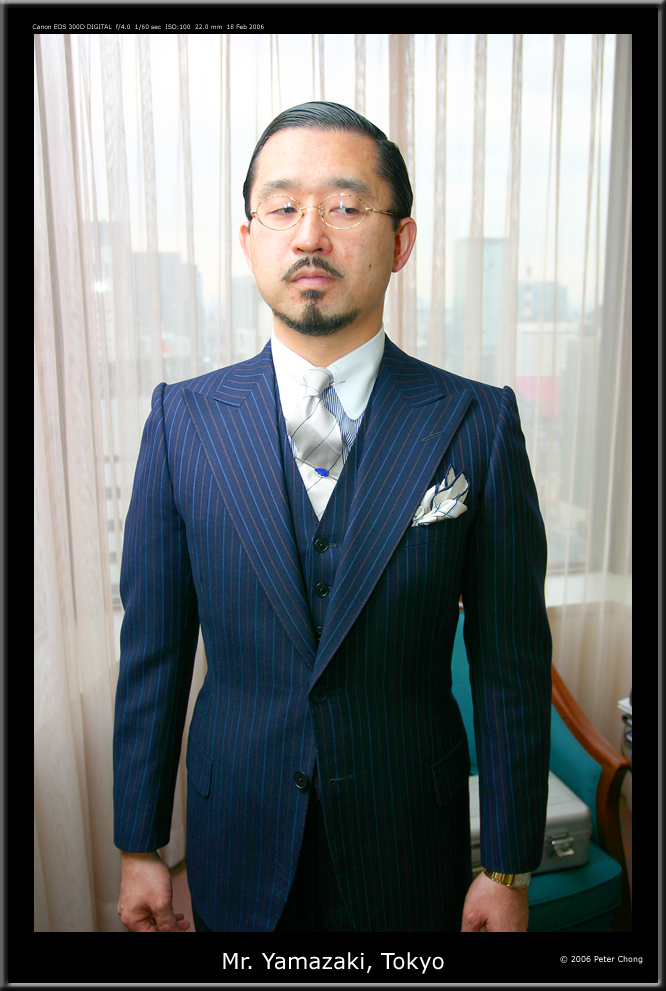Here is a report I posted at The London Lounge, slightly rewritten, on a meeting with Mr. Yamazaki and his stylist - the efferverscent Mr. Okisaka.
Mr. Yamazaki was accompanied by his lovely wife who also acted as translator. I took quite a few pictures during the two hours or so we discussed tailoring, suit design.
Mr Yamazaki wore a beautiful blue suit with multicolor chalk stripes. It is a single breasted design, with large sweeping peak lapels, and was quite stunning. Mr. Okisaka wore the houndstooth double breasted suit.
Mr. Okisaka is not a tailor nor a cutter, but a fashion designer who takes inspiration liberally from the 1930s. He has reached a stage of development in his design career that he is able to freely interprete the elements of the 1930s which suit his sense of style to incorporate into his clothes. This interpretive style is refreshing, his mastery and fluency of the language of design in those years allowed him to either be faithful to the original (like the suit he made for Yamzaki shown here) or to use elements to redisign a suit like the one he is wearing.
A silhoutte of the trio in my hotel room:

Here is a sepia toned photograph of Mr. Yamazaki. Sitting on the chair, he looks regal - reminds me of the late Emperor Hirohito. He is a full blown 1930s chappie, head to toe (except for Crockett & Jones Captoes he wore on Sat). His glasses were vintage looking as was his watch. The suit is particularly beautiful.

And the creator of these suits, Mr. Okisaka - was more flamboyant, and less bound by the 1930s style. His own personal style takes clues from the 1930s, but as mentioned, he is progressed to a stage where he is free to interprete as he pleases.

The Yamazaki 3B SB, 3 piece suit in multi-stripe
The shoulder

Note the heavily roped shoulder, high notch position and large lapels. Note also the handmade buttonaire hole. This style is quite showy. Despite this showy style, it is interesting that the Okisaka-san chose not to use pick stitching on the lapel.
Note also the lapel is cut such that the edge is straight, following closely one of the stripes on the material pattern. Okisaka-san explained to me that he made this so that the lapel looked more angular. Typical English or Italian cut lapels would have a slight curve - known as the belly, which I prefer, and makes the coat look less angular.

The shoulder is hand constructed...picture above showing the inside stitching. The workmanship is immaculate.

Note the angular lapel, with the very high notch position, coupled with a button point which is at approximately midpoint of the coat, and pronounced and pinched waist makes the garment looks rather dramatic. This gives the optical illusion that the wearer is taller than he actually is. The Duke of Windsor used this to great effect.

Level indicating the height of the trousers at the back. The trousers were held by braces, and typical high back, fish tailed.

The back of the coat had a slight fullness around the shoulder blades.

The cloth was a rather interesting vintage material from Thornton-Jones. Lining was apalca wool, which had a very dull finish, rather different from viscose, but still afforded the smoothness to allow one to slide into the coat.

Showing the dart construction. Okisaka-san took great pains to explain that the coat was constructed.

I am not sure if I understand him clearly. But apparently, unlike modern coats, where there is a side panel running all the way from the bottom of the armpit to the coat bottom. This side panel is attached to the rear panel, and the front panel. In his costruction such that the side panel is completely missing, but the front panel extends to meet the rear panel.
Interesting suit, extremely well cut and stitched. But not a style for me...a bit too showy.